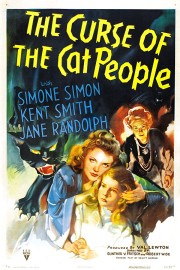The Curse of the Cat People
Oliver Reed and Alice are not very good parents. That’s the first big takeaway I had while watching “The Curse of the Cat People” for this review. For those who may need a reminder, Oliver (Kent Smith) and Alice (Jane Randolph) were a couple that came about during the events of Jacques Tourneur’s classic film, “Cat People.” In that film, Oliver fell in love with an odd, sensual woman named Irena (Simone Simon) who was afraid she would turn into a cat if she gave into her sexual desires for Oliver after they got married. The detachment that grew between the couple led to Oliver falling in love with his co-worker, Alice, and terror as Irena’s jealousy came out. By the end of the film, Oliver and Alice were resolute to marry themselves, and Irena was dead after killing a psychiatrist trying to help her. I watch the film every October, and it holds an unsettling spell every time.
One of the best things that producer Val Lewton did when he began work on a sequel to his first production was bring back the original screenwriter, DeWitt Bodeen, and the result is a direct follow-up that recreates the mood and tone of the original film, but also has the freedom to tell its own story. Years have passed since the events of the first film, and Oliver and Alice are happily married with a child, Amy (Ann Carter), whom they love and adore. Amy is a bit odd, however- she has trouble making friends, and she is an easy target for bullying, especially when she makes a mistake that leads to no one receiving invitations to her birthday party. She has made a friend, though, in an old, strange woman (Julia Dean), an actress who lives alone with her daughter, Barbara (Elizabeth Russell), whom she has suspicions about. She also has an imaginary friend she spends time in the back yard with…it’s Irena, whom she has seen a picture of. Amy’s isolation has Oliver and Alice concerned, and Oliver spends much of the movie telling Amy about the importance of friends, while also questioning the ones she spends time with. With two films of evidence, you kind of wonder how Oliver has any meaningful human interactions.
In case you haven’t figured it out, there is not thematic connection between “Cat People” and “The Curse of the Cat People.” Or is there? This film is not about repressed sexual desires, but a sense of isolation and loneliness women, or girls, can feel when people don’t seek to understand, and empathize, with what they may be feeling. In a way, Amy is feeling exactly the same way that Irena did in the first film, and one can say the same about Julia, the actress Amy befriends. None of these females have people in their lives who accept them for who they are, or they simply take half measures based on their pre-conceived notions to understand them. I’ve seen “Curse of the Cat People” a couple of times previously, over the years, and this is the first time I really touched on this particular connection between the two films. Maybe that is the REAL curse of the cat people. That wasn’t exactly what Lewton had in mind (the title was forced upon him by RKO, who wanted to cash in on the success of the original film), but Bodeen nonetheless found a way to reinforce a lot of what sticks out about the original “Cat People” while also finding something deeper in the characters, and new terrain to explore.
“The Curse of the Cat People” marks the directorial debut of both Gunther V. Fritsch and editor Robert Wise, the latter of whom took over directing the film when Fritsch got behind on the tightly-scheduled and budgeted production. Despite being the work of two directors, the film has a consistent sense of atmosphere and style throughout, and that is because of Lewton being the one overseeing it. All of his productions are supernatural films wherein character trumps scares, mood is more important than gore, and personal details stick out more than big, theatrical gestures in performances. The “Cat People” films were perfect examples of that last one, and it’s why they still cast a spell over 70 years later.










